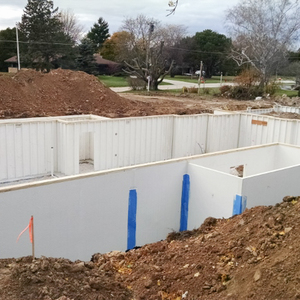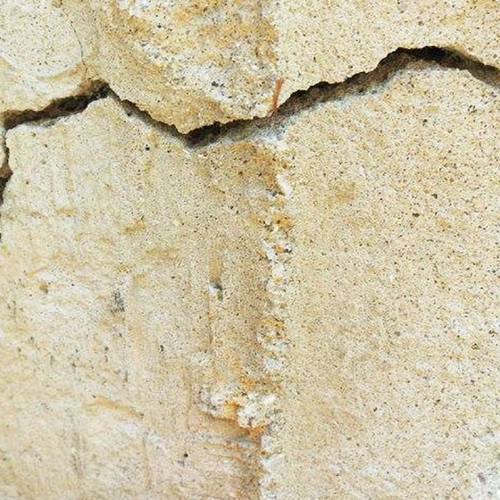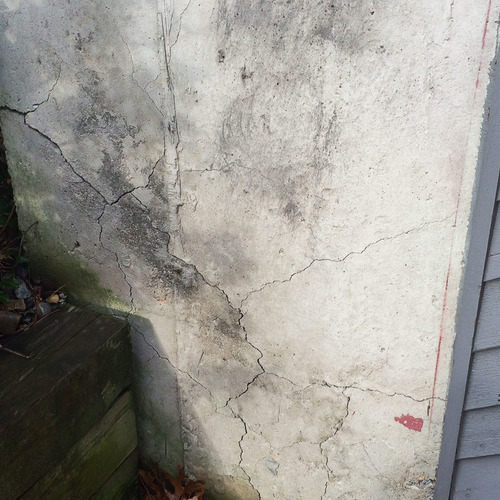
Image Credit: Don Urban / CC BY 2.0/ Flickr
UPDATED May 18
Hundreds of Connecticut homeowners have complained that the concrete foundations holding up their houses are crumbling, and state authorities blame the mineral content of a stone aggregate mined in an eastern Connecticut quarry.
According to an NBC Connecticut report, significant amounts of an iron sulfide mineral called pyrrhotite in rock aggregate is causing foundations to crumble. The station’s report, which shows someone easily flicking away the surface of a concrete wall with the tip of a screw, says that thousands of residential foundations may be affected.
The problem was first reported last July. Most recently, Becker’s Quarry in Willington, Connecticut, and J.J. Mottes Company in neighboring Stafford Springs, a ready-mix concrete supplier, have signed an agreement with the state to stop selling materials that contain aggregate from Becker’s Quarry until June 2017.
The station said it has been told by construction experts the foundations can’t be repaired and must be replaced, which could cost $150,000 or more per home.
The state’s Department of Consumer Protection has heard from 220 homeowners, but the station says that thousands of homes in the eastern part of the state could be affected.
In a written statement, Connecticut Attorney General George Jepsen said, “Although that investigation will continue into the fall, we believe there is now sufficient evidence to conclude that significant levels of the mineral pyrrhotite in stone aggregate used in the production of concrete is a substantial contributing factor to the crumbling foundations experienced by some homeowners in eastern Connecticut… Further efforts are necessary to understand the full range of contributing factors and the manner that all factors interact to produce concrete deterioration.”
The problem appears to be limited to residential foundations, and the aggregate from Becker’s quarry can still be used in commercial applications, the station said.
Firms say that installation is the problem
A spokesman for the Joseph J. Mottes Company, which has leased its property and equipment to a another Connecticut firm for the 2016 building season, said that the failures were an “installation issue.”
“We strongly believe that the current situation involving residential foundations in eastern Connecticut is an installation issue, and we support an unbiased and comprehensive investigation of these foundation issues — including how the materials were placed and installed, in addition to remedial actions — so that homeowners can get the answers they deserve and meaningful help with solutions,” Mottes spokesman John Patton told the Hartford Courant.
Patton didn’t elaborate on what kind of installation errors might have contributed to the problem.
Neither the American Society of Concrete Contractors nor the American Concrete Institute (ACI) could produce a single technical expert to discuss the potential risks of using aggregate with high pyrrhotite content, or whether the problem has been reported in other parts of the country.
A search of ACI’s online archives for “pyrrhotite” turned up just two entries. One of them is an article abstract dating from 1959, which said in part, “In the Oslo region of Norway, alum shales containing small amounts of the unstable iron sulfide, pyrrhotite, produce an unusual form of sulfate attack upon concrete placed in or near these deposits, and cause deterioration if they are used as concrete aggregate.”
The rest of the article is behind a pay wall.
Problems in Quebec reported in 2002
Pyrrhotite-laced aggregate apparently hasn’t attracted much attention in the U.S., but a well-documented case in Quebec near Trois-Rivieres has involved more than a thousand homes, according to the website Pyrite Problem.
Reports that houses were showing concrete problems related to the pyrrhotite content of aggregate began trickling in back in 2002. Later, the list of problem structures grew to include more than a thousand houses, a bridge and commercial buildings.
The website, the work of an engineering geologist named Tom St. John, includes case histories, a variety of references, and a summary spanning more than a decade of news coverage taken from two Canadian news outlets, La Presse, a website, and Le Nouvelliste, a newspaper.
The coverage begins in 2001 when a company called Laurentide Concrete received its first claims for problems related to deteriorating concrete. By 2009, a group called the Concrete Coalition (later the Coalition of Victims of Pyrrhotite) had been formed, and two years later Quebec announced a fund of $15 million, later expanded to $30 million, to help people with failing foundations.
According to the website’s summary, a legal battle that began in 2012 eventually resulted in a finding of liability mostly on the part of a concrete company and an engineering consultant of $196 million. The finding was appealed.
Last month, Prime Minister Justin Trudeau said the federal government would spend $30 million over three years to help homeowners. An advocates group believes as many as 4,000 homes may be affected, according to a news report.
Connecticut homeowners tell their stories
A website for a homeowners’ group called the Connecticut Coalition Against Crumbling Basements says that the homes with problematic concrete in northeastern Connecticut and southern Massachusetts were built in the 1980s and 1990s.
“The damage appears to take decades or more to appear, yet there is no magic number or formula to determine the rate at which a home will begin to fail, or when it will become unsound to inhabit,” the site says. “The date range of 1980 to 1998 is only a current estimate.”
The only solution appears to be a complete foundation replacement, and neither the state nor homeowners’ insurance companies have been much help.
A number of homeowners have posted their stories at the site, recalling expensive and unsuccessful attempts to patch cracking concrete, frustrating conversations with insurance companies, and financial and emotional distress.
“The company experts who patched our foundation told us the cracking would stop at some point, and they said their patching would fix the problem,” one homeowner wrote. “We paid them thousands of dollars for patching in 2013 and now the cracking has accelerated. We do not have much time left. I’m 61 years old and we wife is 59, and we are facing serious financial problems.”
Another wrote, “In 2012 I considered selling my duplex since the outside work and upkeep cost involved in being a landlord had become physically and financially excessive. It was quite a shock when my realtor told me my home was unsalable due to the crumbling concrete in the foundation of the rental side.
“I immediately contacted my insurance company, which informed me they would only cover a collapsed foundation, not one in the process of collapsing,” the account continues. “The irony is, since I reported the problem, I was no longer covered if the house did in fact collapse. In the mind of the insurance company, I was aware of the problem and did not correct it. “
Weekly Newsletter
Get building science and energy efficiency advice, plus special offers, in your inbox.















5 Comments
commercial vs residential
I am puzzled that it's deemed OK in commercial construction. How can the concrete tell whether it's in a residential or commercial application?
Response to Charlie Sullivan
Charlie,
I'm just speculating, but the warning may be limited by the wording of consumer protection laws in Connecticut (and the legal definition of "consumer") rather than by the nature of commercial concrete mixes.
According to the press release issued by the Connecticut Department of Consumer Protection, "While this agreement only applies to use of products in residential construction, the Attorney General and Commissioner Harris urge commercial and public project managers to continue to exercise strict control and scrutiny over the quality of concrete products used in their projects. To date, the state's investigation has documented concrete deterioration of a comparable nature in a number of residential foundations but has not revealed similar evidence of failures of commercial or public building foundations."
Now what?
I would expect that architects and engineers would specify that aggregate not contain the suspect material. I'd also expect that lawyers would advise their clients (builders, redi-mix companies, owners, designers) to avoid the material.
In some jurisdictions, there is a statute of repose which imposes a time limit after which no liability may be imposed for defects in construction, even if unknown or unknowable. If that is the case in CT, the homeowners may not have any remedy against design professionals or contractors.
Insurance Company Response
The insurance company response to the duplex homeowner is typical. They've invented a catch 22 where they won't pay because the foundation hasn't collapsed and if it collapses they still won't pay. This just means the homeowner must find a good lawyer.
If the aggregates degraded
If the aggregates degraded residential concrete then it would effect all similar mixes, the concrete doesn't know where it was used. Unless different cement types were used and typically sulfate resistant cements are more expensive. If someone knew to use a different cement in a commercial project, they would have (should have?) known to use it on every mix with that aggregate.
Legally this will get into standard of care, and statute of repose. Unless there was negligence and someone knew it was bad and purposefully did nothing, there may not be much recourse.
Sulfate, if indeed in the aggregate, causes a degrading chemical reaction with one of the possible components in the cement portion of a concrete mix. It can be addressed by using the right type of cement per ASTM, either Type II for moderate resistance or Type V for severe. These types have lower concentrations of the component that reacts negatively.
Sulfate is generally a concern from soils and would be identified as part of a geotechnical investigation for a project or neighborhood. If in the aggregates that is definitely unusual. It would take time to cause problems, but should also have a finite downside versus with soils it can continue to leach into the concrete. Engineers typically do try to avoid any exposure of concrete to sulfates or chlorides. The aggregate pits are supposed to test the properties of their product, doesn't mean that it is done regularly enough as various layers are excavated. Regardless, my experience is that residential concrete is exceedingly lax in the quality of concrete delivered to projects. There is a lack of any reasonable review process of the mix designs and properties of the components in the mix. The extent of quality specification rarely extends beyond the phone call ordering the truck that day and what strength, 3000 or 4000 psi, or use, driveway slab or grade beam, etc.
Log in or create an account to post a comment.
Sign up Log in